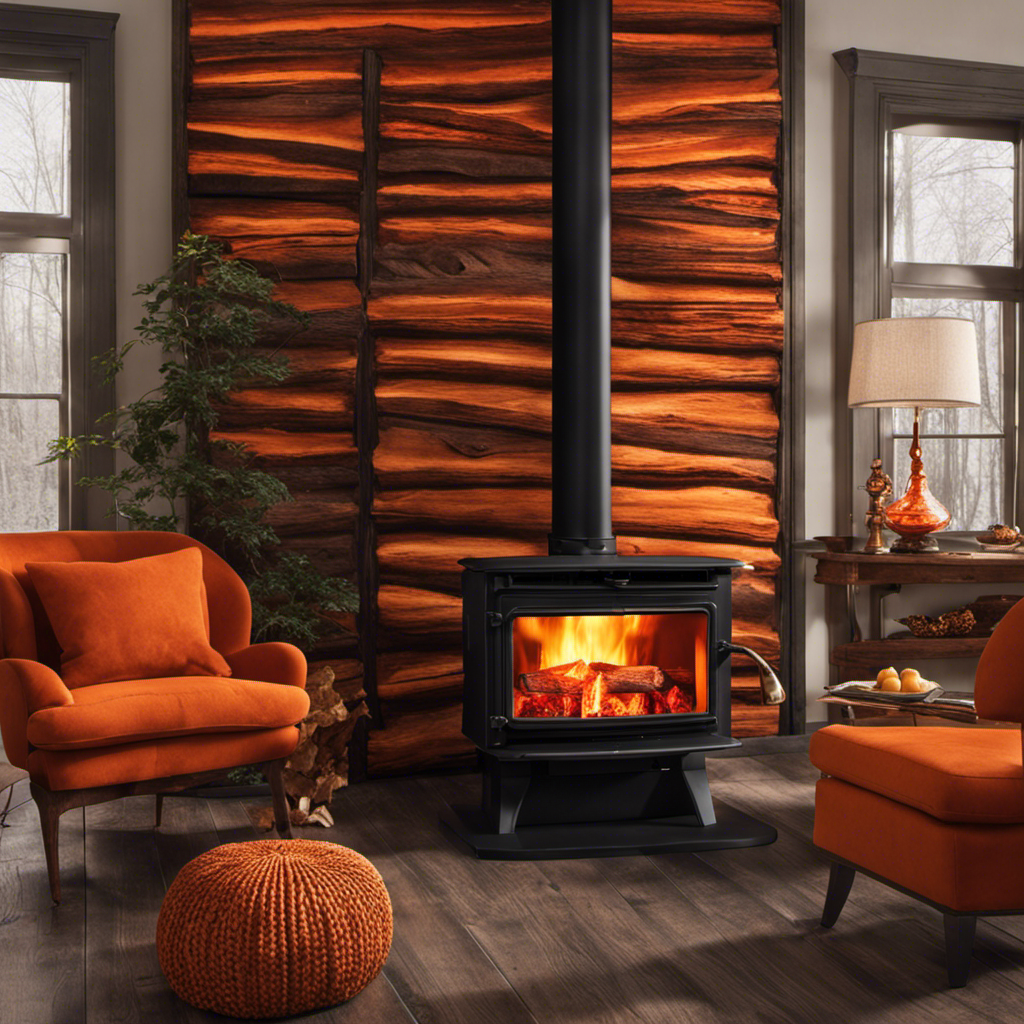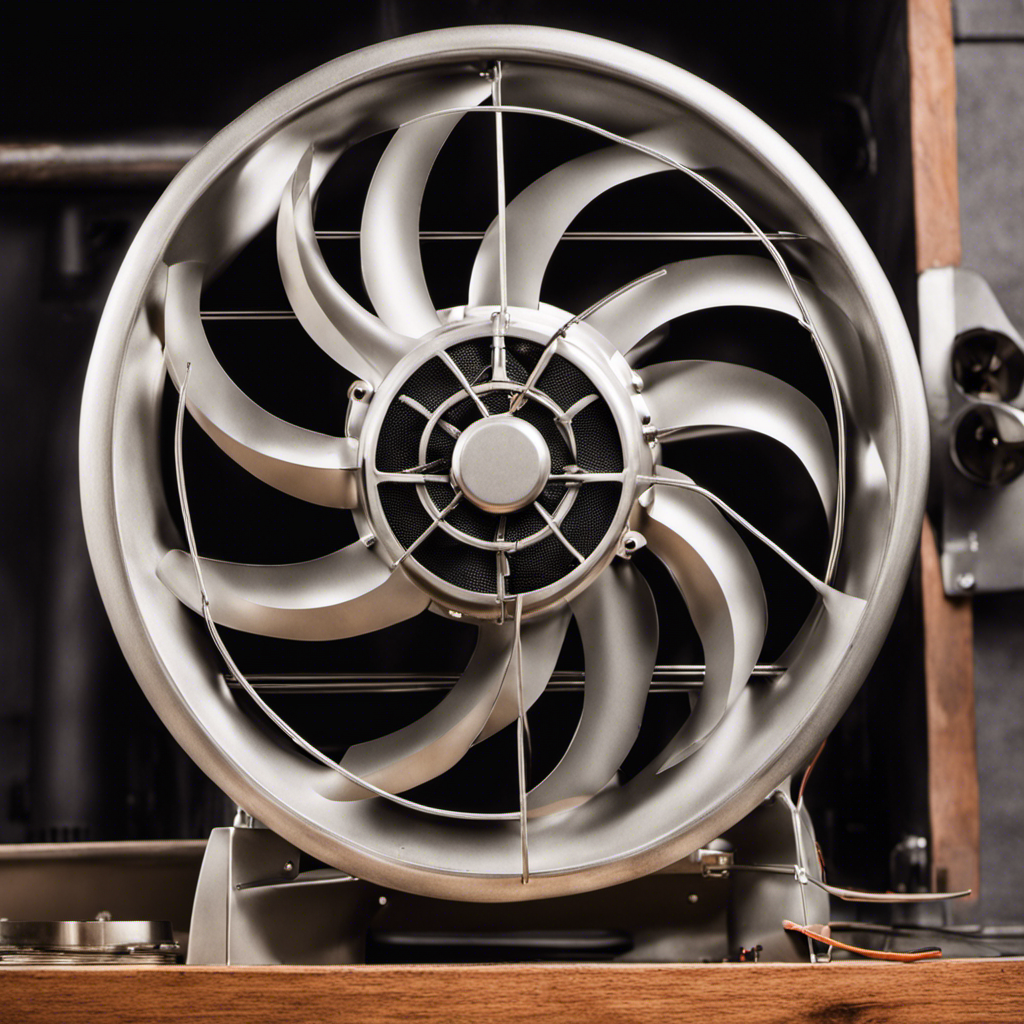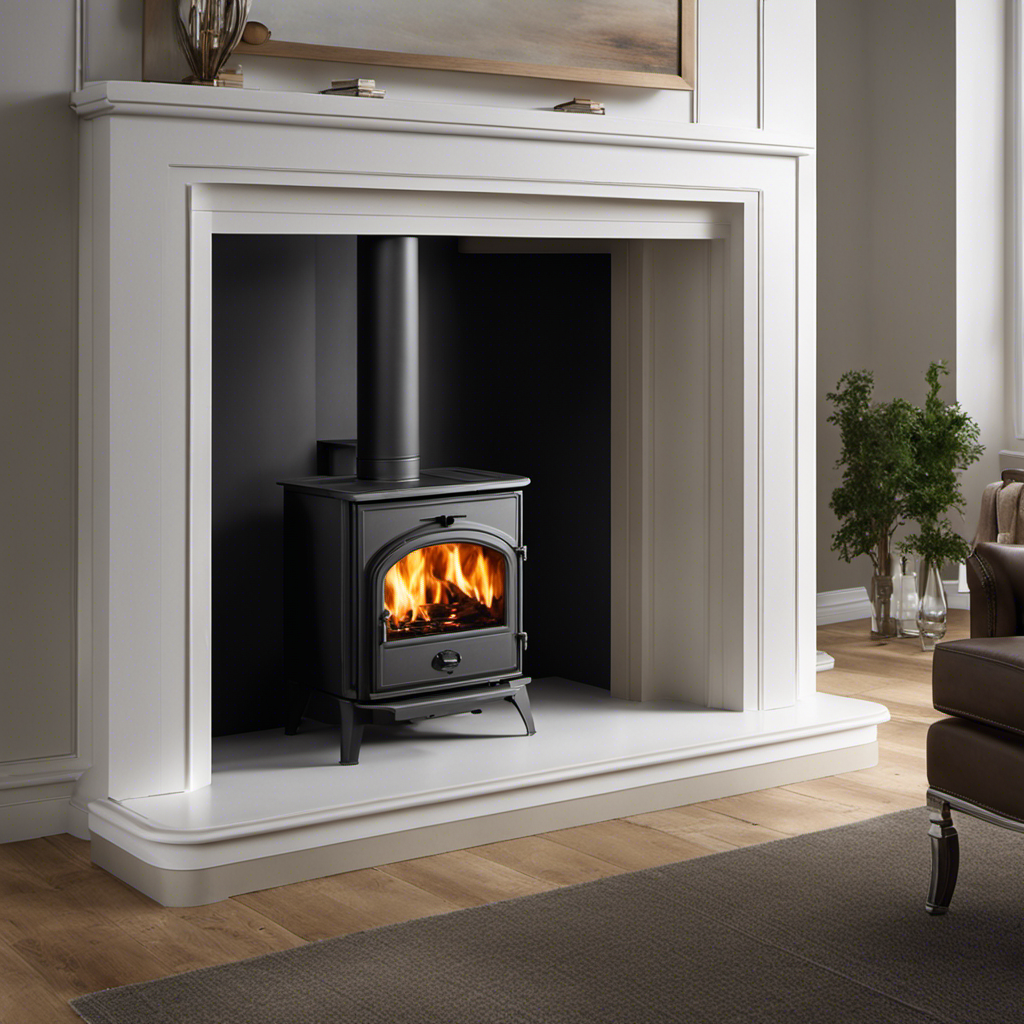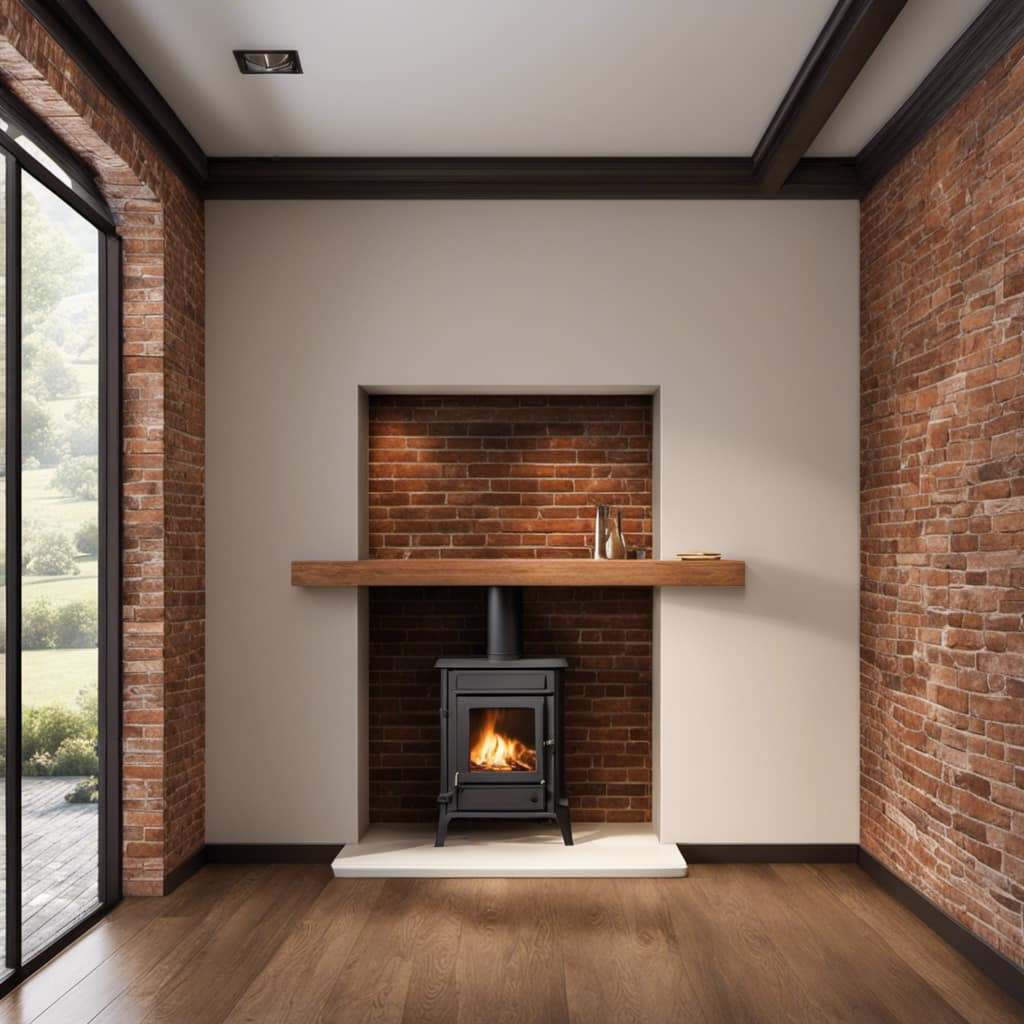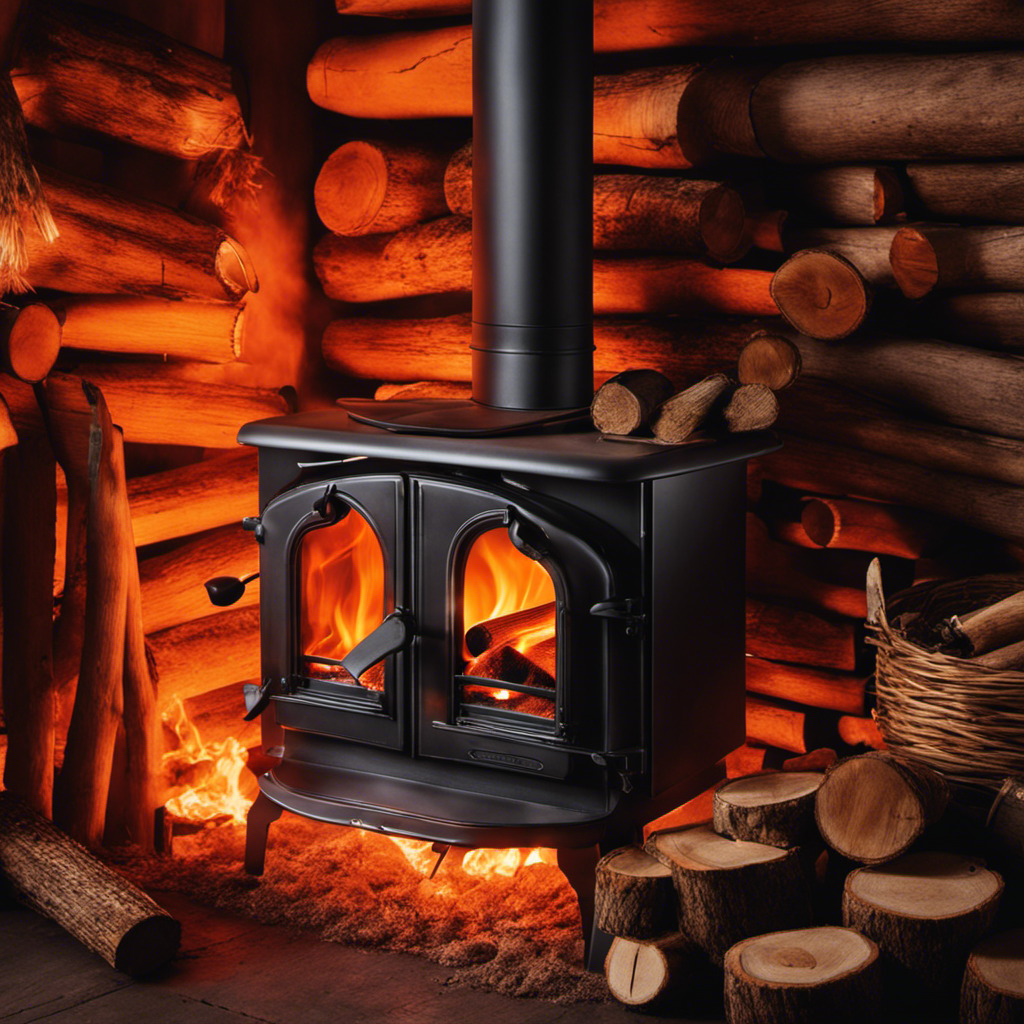Did you know that a wood stove can generate over 30,000 British Thermal Units (BTUs) of heat per hour? This amount of warmth can easily heat up an entire room!
In this article, I’ll dive into the factors that determine the heat output of a wood stove, from the type of stove to the wood being burned.
I’ll also share tips on maximizing heat efficiency and compare wood stove heat output to other heating options.
Get ready to cozy up by the fire!
Key Takeaways
- The size and design of the wood stove, the type of wood being burned, the moisture content of the wood, and the air intake and control settings all impact the heat output of a wood stove.
- BTUs (British Thermal Units) are used to measure heat output, and it is important to calculate the heat output and determine the BTU requirements when choosing a wood stove.
- The efficiency ratings of wood stoves can vary among different models, and using proper burning techniques and seasoned wood can maximize heat production.
- Wood stoves have a higher heat output compared to electric heaters, and they can provide heat during power outages, but they require regular maintenance and a constant supply of wood. Electric heaters offer convenience and lower maintenance. The choice between wood stoves and electric heaters depends on individual preferences and heating needs.
The Factors That Determine Heat Output
The factors that determine the heat output of a wood stove are important to consider when evaluating its efficiency. Several key factors affect the heat output of a wood stove.
The first factor is the size and design of the stove. A larger stove with a better design can produce more heat.
The second factor is the type of wood being burned. Hardwoods, such as oak or maple, produce more heat than softwoods, like pine.
The third factor is the moisture content of the wood. Dry wood burns more efficiently and produces more heat.
Lastly, the air intake and control settings of the stove play a role in heat output. By adjusting the airflow, you can regulate the amount of heat being generated.
Understanding these factors is crucial in understanding BTUs: what they’re and how they relate to wood stoves.
Understanding BTUs: What They Are and How They Relate to Wood Stoves
I can explain how BTUs, or British Thermal Units, are important in understanding the heat output of wood stoves.
BTUs are a unit of measurement used to quantify the amount of heat energy produced by a particular fuel source. When it comes to wood stoves, calculating heat output is crucial in determining the BTU requirements for your space.
This calculation takes into account factors such as the size of the area to be heated, the insulation of the space, and the desired temperature.
Additionally, the quality of the wood used in the stove can greatly impact heat production. Dry and seasoned hardwoods, such as oak or maple, tend to yield more heat output compared to softwoods or wet wood, which have lower BTU values.
Therefore, understanding BTUs and considering wood quality are essential in maximizing the efficiency and effectiveness of your wood stove.
Types of Wood Stoves and Their Heat Production
To maximize heat production, it is important to consider the different types of wood stoves available and their efficiency. Wood stoves are a popular choice for heating homes due to their cost-effectiveness and environmental benefits. When choosing a wood stove, it is crucial to look at the efficiency ratings of different models. Efficiency ratings indicate how effectively a wood stove converts wood fuel into heat. To give you a better understanding, here is a comparison table showcasing the efficiency ratings of five popular wood stove models:
| Wood Stove Model | Efficiency Rating |
|---|---|
| Model A | 70% |
| Model B | 75% |
| Model C | 80% |
| Model D | 85% |
| Model E | 90% |
Wood stoves, when used properly, can have a lower environmental impact compared to other heating methods. Wood is a renewable resource, and modern wood stoves are designed to burn wood efficiently, reducing emissions. However, it is essential to follow proper burning techniques and use seasoned wood to minimize environmental impact. Now that we understand the efficiency ratings and environmental benefits of wood stoves, let’s explore some tips for maximizing heat efficiency in your wood stove.
Tips for Maximizing Heat Efficiency in Your Wood Stove
Honestly, I’ve found that using dry and seasoned wood, along with proper air circulation, can greatly maximize the heat efficiency in my wood stove.
Here are three tips for proper maintenance and cleaning of wood stoves, as well as common mistakes to avoid when using one:
-
Regularly clean the ash: Removing the accumulated ash from the firebox and ash pan ensures proper airflow and prevents the build-up of creosote, which can lead to chimney fires.
-
Check the door gasket: A worn-out or damaged door gasket can cause air leakage, reducing the stove’s efficiency. Replace it if necessary to maintain a tight seal.
-
Control the air intake: Adjusting the air intake controls helps regulate the burn rate and temperature. Too much air can result in excessive heat loss, while too little air can cause poor combustion and increased creosote formation.
By following these tips, you can ensure optimal heat efficiency in your wood stove.
Now, let’s examine how wood stove heat output compares to other heating options.
Comparing Wood Stove Heat Output to Other Heating Options
I’ve found that wood stove heat output is often more efficient and cost-effective compared to other heating options available. When comparing the efficiency of wood stoves to electric heaters, there are several factors to consider. Firstly, wood stoves can produce a higher amount of heat, typically ranging from 60,000 to 100,000 British Thermal Units (BTUs), while electric heaters usually have a lower heat output, ranging from 3,000 to 10,000 BTUs. Additionally, wood stoves can provide heat even during power outages, making them a reliable option. However, it’s important to note that wood stoves require a constant supply of wood and regular maintenance. Electric heaters, on the other hand, are more convenient to use and require less maintenance. Ultimately, the choice between wood stoves and electric heaters depends on individual preferences and specific heating needs.
| Pros of Wood Stoves | Cons of Wood Stoves |
|---|---|
| High heat output | Requires constant supply of wood |
| Reliability during power outages | Regular maintenance needed |
| Cost-effective in the long run | Potential for air pollution |
| Adds ambiance and aesthetic value to the space | Requires proper ventilation |
| Pros of Electric Heaters | Cons of Electric Heaters |
|---|---|
| Convenient and easy to use | Lower heat output |
| No need for fuel storage | Dependence on electricity supply |
| Safer option, no risk of fire or carbon monoxide poisoning | Higher operating costs |
| Portable and versatile | Limited heating range |
Frequently Asked Questions
How Long Does It Take for a Wood Stove to Heat up a Room?
It takes a wood stove some time to heat up a room, depending on various factors. Factors such as the wood stove efficiency, insulation of the room, and the size of the room can affect the heating time.
Can a Wood Stove Be Used as the Sole Source of Heating for a House?
Using a wood stove as the main heating source for a home can be cost-effective and environmentally friendly. It provides warmth and comfort, reducing reliance on other heating systems.
Are There Any Safety Precautions That Need to Be Taken When Using a Wood Stove?
When using a wood stove, it’s crucial to take safety measures to prevent accidents. Regular maintenance is necessary for optimal functioning. Follow these tips to ensure a safe and efficient wood stove operation.
Can a Wood Stove Be Used in an Area With Poor Ventilation?
Yes, a wood stove can be used in an area with poor ventilation, but it is not recommended. Poor ventilation can lead to decreased wood stove efficiency and pose dangers such as carbon monoxide buildup.
Is It Possible to Control the Heat Output of a Wood Stove?
Controlling the heat output of a wood stove is crucial for maintaining a comfortable temperature. By adjusting the air intake and fuel supply, I can regulate the wood stove’s efficiency and ensure optimal heating conditions.
Conclusion
In conclusion, wood stoves are an efficient and sustainable heating option for your home. With an average heat output of 30,000 to 100,000 BTUs per hour, they can effectively warm up a room or even an entire house.
Compared to other heating options, wood stoves provide a unique ambiance and cost-effective solution. So, if you’re looking for a reliable and cozy way to stay warm, consider investing in a wood stove.
You won’t be disappointed.
Growing up surrounded by the vast beauty of nature, Sierra was always drawn to the call of the wild. While others sought the comfort of the familiar, she ventured out, embracing the unpredictable and finding stories in the heartbeat of nature.
At the epicenter of every remarkable venture lies a dynamic team—a fusion of diverse talents, visions, and passions. The essence of Best Small Wood Stoves is crafted and refined by such a trio: Sierra, Logan, and Terra. Their collective expertise has transformed the platform into a leading authority on small wood stoves, radiating warmth and knowledge in equal measure.

